Read more about the native trees that you will encounter here at Suncadia!
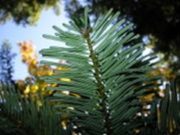
Grand Fir-Abies grandis is a fir native to the Pacific Northwest of North America, occurring at altitudes of sea level to 1,800 m. It is a large evergreen coniferous tree growing to 40-70 m (exceptionally 80 m) tall and with a trunk diameter of up to 2 m.
The leaves are needle-like, flattened, 3-6 cm long and 2 mm wide by 0.5 mm thick, glossy dark green above, and with two green-white bands of stomata below, and slightly notched at the tip. The leaf arrangement is spiral on the shoot, but with each leaf variably twisted at the base so they all lie in two more-or-less flat ranks on either side of the shoot. The cones are 6-12 cm long and 3.5-4.5 cm broad, with about 100-150 scales; the scale bracts are short, and hidden in the closed cone. The winged seeds are released when the cones disintegrate at maturity about 6 months after pollination.
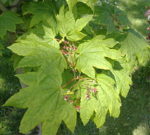
Vine Maple – Acer- cirinatum – the gnarled and crooked appearance of the Vine Maple tree probably lends itself to the word ‘vine’ in its common name ‘acer’ is the Latin word for a maple tree. Vine Maples appears as a small tree or shrub and can grow into a dense thicket.
Vine Maple is a crooked, short-trunked tree that can sometimes grow almost horizontally and may root where it touches the ground and have twisted, spreading limbs. The crown is low and irregularly shaped. Vine Maple likes wet sites, along river and stream banks. They grow up to 20 meters in height. The bark is thin, smooth, may have shallow cracks at the base of the tree when older greenish when young, turning reddish-brown or gray with age. The flowers small, reddish or purple, often just one fruit will appear on each. The leaves have 7 to 9 lobes that are almost circular, 6 to 11 cm in diameter and toothed. When mature bright yellowish-green on top with a pale green and downy underside When young reddish and hairy and turn red and gold in the fall
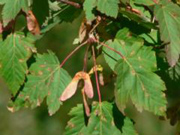
Rocky Mountain Maple- Acer glabrum is a maple native to western North America, from southeastern Alaska, British Columbia, and western Alberta, east to western Nebraska, and south through Washington, Montana and Colorado to California, Arizona and New Mexico. It is plentiful in many parts of the Rocky Mountains, often growing with Ponderosa pine, Douglas-fir, and trembling aspen.
It is a deciduous shrub or small tree growing to 10 m tall, with a trunk up to 20-30 cm diameter. The leaves are 2-10 cm broad, three-lobed (rarely five-lobed), variable in the depth of lobing, occasionally so deeply lobed as to be divided into three leaflets; the lobes have an acute apex and a coarsely serrated margin.
The flowers are produced in corymbs of five to ten, yellowish-green, at the same time as the new leaves in spring. The fruit is a samara with two winged seeds.
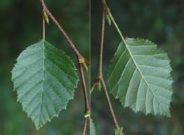
Alder Sitka- Alnus situate Also known as mountain alder, grows to be about 1-5 meters tall. There are many scientific names for this plant such as: A. sinuata, A. viridus, or A. sitchensis. The bark on Sitka alder is yellowish-brown and scaly. It grows best in moist areas, such as edges of wet meadows, avalanche tracks, and near streams. Sitka alder dominates the shorelines and places where a glacier has recently melted. It can also form dense shrub thickets and take over wet avalanche tracks. Since the branches are so flexible, the snow slides over them without breaking.
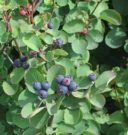
Western Serviceberry-Amelanchier alnifolia is a species of Amelanchier native to North America in Alaska, across most of Canada from Yukon south and eastward to British Columbia and western Quebec, and in the western and north-central United States south to northern California, Utah and northern Iowa. It grows from sea level in the north of the range, up to 2,600 m altitude in California and 3,400 m in the Rocky Mountains.
It is a deciduous shrub or small tree that can grow to 1–8 m (rarely to 10 m) in height. Its growth form spans from suckering and forming colonies to clumped. The leaves are oval to nearly circular, 2-5 cm long and 1–4.5 cm broad, with margins dentate mostly above the middle and a 0.5–2 cm petiole. The flowers are white, about 2-3 cm across; they appear on racemes of 3–20 together in early spring while the new leaves are still expanding. The fruit is a small purple pome 5-15 mm diameter, ripening in early summer
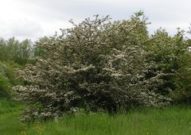
Hawthorne- Crataegus columbiana is a large genus of shrubs and trees in the family Rosaceae, native to temperate regions of the Northern Hemisphere in Europe, Asia, and North America. The name hawthorn was originally applied to the species native to northern Europe, especially the Common Hawthorne C. monogyna, and the unmodified name is often so used in Britain and Ireland. However, the name is now also applied to the entire genus, and also to the related Asian genus Rhaphiolepis.
They are shrubs and small trees growing to 5-15 m tall, characterized by their small pome fruit and thorny branches. The bark is smooth grey in young individuals, developing shallow longitudinal fissures with narrow ridges in older trees. The fruits are sometimes known as “haws”, from which the name derived. The thorns grow from branches and are typically 1-3 cm long. The leaves grow spirally arranged on long shoots, and in clusters on spur shoots on the branches or twigs. The leaves themselves have lobed or serrate margins and are a somewhat variable shape.
Hawthornes provide food and shelter for many species of birds and mammals, and the flowers are important for many nectar-feeding insects. Hawthorns are also used as food plants by the larvae of a large number of Lepidoptera species —Hawthornes are among the trees most recommended for water conservation landscapes.

Western Larch–Larix occidentalis is a species of larch native to the mountains of western North America, in Canada in southeastern British Columbia and southwestern Alberta, and in the United States in eastern Washington, eastern Oregon, northern Idaho, and western Montana.
It is a large deciduous coniferous tree reaching 30-60 m tall, with a trunk up to 1.5 m diameter. The crown is narrow conic; the main branches are level to upswept, with the side branches often drooping. The shoots are dimorphic, with growth divided into long shoots (typically 10-50 cm long) and bearing several buds, and short shoots only 1-2 mm long with only a single bud. The leaves are needle-like, light green, 2-5 cm long, and very slender; they turn bright yellow in the fall, leaving the pale orange-brown shoots bare until the next spring.
The cones are ovoid-cylindric, 2-5 cm long, with 40-80 seed scales; each scale bearing an exserted 4-8 mm bract. The cones are red when immature, turning brown and the scales opening flat or reflexed to release the seeds when mature, 4-6 months after pollination. The old cones commonly remain on the tree for many years, turning dull gray-black.
It grows at 500-2,400 m altitude and is very cold tolerant, able to survive winter temperatures down to about −50 °C. It only grows on well-drained soils, avoiding the waterlogged ground.
The seeds are an important food for some birds, notably Pine Siskin, Common Redpoll and White-winged Crossbill.
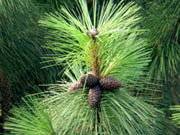
Ponderosa Pine- Pinus ponderosa Range – Ponderosa Pine is one of America’s abundant tree species, covering approximately 27 million acres of land. Stands can be found from Canada to Mexico and from the Pacific Coast eastward to the Black Hills of South Dakota. Its growth range covers an area encompassing more than 35 percent of the total acreage of the U.S.
California, Oregon and Washington account for a major share of the annual harvest. Arizona and South Dakota are also important producing areas with lesser amounts coming from Idaho, Wyoming, Montana, Utah and New Mexico.
Growth Habits – Ponderosa Pine trees average 100′ to 160′ in height, with some exceeding 180′. The trees range from 2-4′ in diameter, with the rate of growth depending upon altitude, soil, temperature and rainfall.
Mature Ponderosa Pines can be easily identified by their distinctive orange-brown bark which is arranged in large plates. The dark yellow-green needles are 5-10″ long and grow in clusters of three. The cones, similar in color to the bark, are 3-6″ long and 2-4″ in diameter. Seeds are 5/16-3/8″ long with a 3/4-1″ wing.
In pure, or nearly pure, stands of Ponderosa Pine there is a standing inventory of approximately 188 billion board feet of lumber; in mixed stands there are additional billions of board feet in unmeasured inventory. Most Ponderosa trees grow, mature and survive for about 125 years before they are lost to natural causes such as rot, insect damage, fires or wind throw. Occasionally, a lone specimen will survive for nearly 200 years. Their typical site is on semi-arid plateaus and slopes, often surrounded by juniper and sage.
Ponderosa Pine forests are usually selectively harvested rather than clear cut. This method of logging removes only the mature trees and leaves the other trees to re-seed and mature. Selective harvesting often makes it difficult to identify a recently logged stand.
Ponderosa Pine (pinus ponderosa) is one of the Western pine species that includes Idaho White Pine (pinus monticola), Sugar Pine (pinus lambertiana) and Lodgepole Pine (pinus contorta). The Western pines are distinct from the Southern Yellow pines which are denser and pitchier, with widely different characteristics and uses.
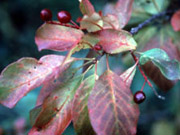
Common Chokecherry- Prunus virginiana is a species of bird cherry (Prunus subgenus Padus) native to North America, where it is found almost throughout the continent except for the deep south and the far north. It is a suckering shrub or small tree growing to 5 m tall. The leaves are oval, 3-10 cm long, with a coarsely serrated margin. The flowers are produced in racemes of 15-30 in late spring (well after leaf emergence). The fruit is about 1 cm diameter, bright red, with a very astringent, sour taste. Like chokeberries, chokecherries are very high in antioxidant pigment compounds, like anthocyanins.
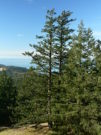
Douglas Fir- Pseudotsuga Manziesii is the common name applied to coniferous trees of the genus Pseudotsuga in the family Pinaceae. There are five species, two in western North America, one in Mexico and two in eastern Asia. The Douglas-firs gave 19th-century botanists problems due to their similarity to various other conifers better known at the time; they have at times been classified in Pinus, Picea, Abies, Tsuga, and even Sequoia. Because of the distinctive cones, Douglas-firs were finally placed in the new genus Pseudotsuga (meaning “false Tsuga”) by the French botanist Carrière in 1867.
The common name honors David Douglas, the Scottish botanist who first introduced the tree into cultivation in 1826. Douglas is known for introducing many North American native conifers to Europe. The hyphen in the common name indicates that Douglas-firs are not true firs; i.e. they are not members of the genus Abies.[1]
The Douglas-firs are medium-size to large or very large evergreen trees, to 20-100 m tall. The leaves are flat and needle-like, generally resembling those of the firs. The female cones are pendulous, with persistent scales (unlike true firs), and are distinct in having a long Tridentine (three-pointed) bract that protrudes prominently above each scale.
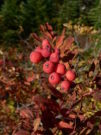
Mountain Ash – Serbs sitchensis, is a small shrub of the western United States.
A multi-stemmed shrub is indigenous to the Pacific Coast of North America.
- Winter buds: Not sticky with rusty hairs.
- Leaves: Alternate, compound, six to ten inches long, Leaflets seven to ten, blue-green, lanceolate or long oval, with a rounded tip, toothed usually from the middle to the end. In autumn they turn yellow, orange and red. Stipules leaf-like, caducous.
- Flowers: After the leaves are full grown. White, small, 80 or fewer, borne in flat compound cymes three or four inches across.
- Fruit: berry-like pome, globular, one-quarter of an inch across, bright red, borne in cymous
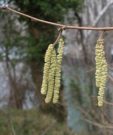
Hazelnut-Corylus cornuta
It is typically a shrub reaching 3-8 m tall but can reach 15 m. The leaves are deciduous, rounded, 6-12 cm long and across, softly hairy on both surfaces, and with a double-serrate margin. The flowers are produced very early in spring before the leaves and are monoecious, with single-sex wind-pollinated catkins; the male catkins are pale yellow and 5-12 cm long, while the female catkins are very small and largely concealed in the buds, with only the bright red 1-3 mm long styles visible. The fruit is a nut, produced in clusters of one to five together, each nut held in a short leafy involucre (‘husk’) which encloses about three-quarters of the nut. The nut is roughly spherical to oval, 15-20 mm long and 12-20 mm broad (larger, up to 25 mm long, in some cultivated selections), yellow-brown with a pale scar at the base. The nut falls out of the involucre when ripe, about 7-8 months after pollination.